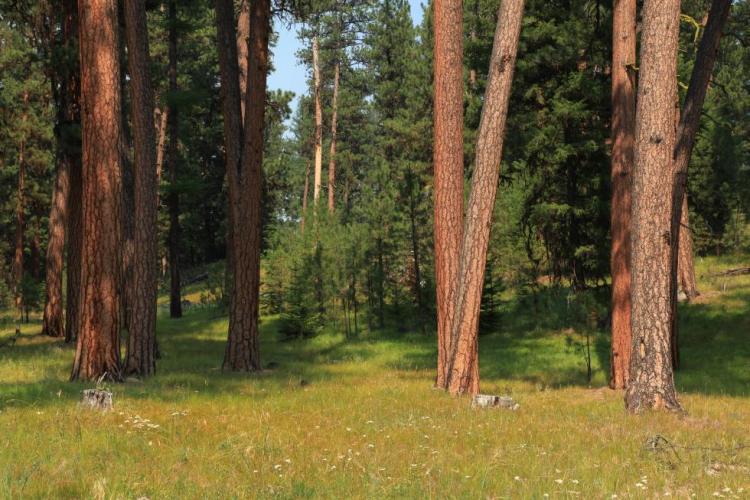
Ponderosa pine woodlands are dominated by ponderosa pine, but may also have lodgepole pine, western juniper, aspen, western larch, grand fir, Douglas-fir, mountain mahogany, incense cedar, sugar pine, or white fir, depending on ecoregion and site conditions. Their understories are variable combinations of shrubs, herbaceous plants, and grasses.
Ecoregional Characteristics
Blue Mountains
Ponderosa pine habitats also include savannas, which have widely-spaced trees (canopies of less than 1 percent) that are generally more than 150 years old. The structure of a savanna is open and park-like with an understory dominated by fire-adapted grasses and forbs as well as shrub fields. Ponderosa pine habitats generally occur at mid elevation and are replaced by other coniferous forests at higher elevations.
East Cascades
Ponderosa pine habitats generally occur at mid elevation and are replaced by other coniferous forests at higher elevations.
Klamath Mountains
Pine or pine-oak woodlands occur on dry, warm sites in the foothills and mountains of southern Oregon. Here, pine woodlands are usually dominated by ponderosa pine, but may be dominated by Jeffery pine, depending on soil mineral content, fertility, and temperatures. The understory often has shrubs, including green-leaf manzanita, buckbrush, and snowberry. Pine-oak woodlands are found primarily in valley margins and foothills on rolling plains or dry slopes. The structure is park-like with an open grassy or shrubby understory.
Limiting Factors and Recommended Approaches
Limiting Factor: Altered Fire Regimes and Addressing Risk of Uncharacteristically Severe Wildfire
Past forest practices and fire suppression have resulted in either dense growth of young pine trees or dense, young mixed conifer stands, depending on local site conditions and natural climax species. These dense stands are at increased risk of uncharacteristically severe wildfires, disease, and damage by insects. Over time, some stands will convert to Douglas-fir and grand fir forests, which do not provide adequate wildlife habitat for species dependent on open ponderosa pine habitats. Particularly in the Blue Mountains and East Cascades ecoregions, dense understories and insect-killed trees make it difficult to reintroduce natural fire regimes. In parts of the East Cascades and Klamath Mountains, increasing home and resort development in forested habitats makes prescribed fire difficult in some areas and increases risk of high-cost wildfires.
Recommended Approach
Use an integrated approach to forest health issues that considers historical conditions, including roads and human use, wildlife conservation, natural fire intervals, and silvicultural techniques. Develop implementation plans for prescribed fire that are acceptable for management of both game and non-game species. Evaluate individual stands to determine site-appropriate actions, such as monitoring in healthy stands, or thinning, mowing, and prescribed fire in at-risk stands. Implement fuel reduction projects to reduce the risk of forest-destroying wildfires. Reintroduce fire where feasible. Thin stands where appropriate, and develop markets for small-diameter trees.
Implement fuel reduction projects to reduce the risk of forest-destroying wildfires, considering site-specific conditions and goals. Consider prescribed fire where appropriate, given safety and wildlife management concerns. Fuel reduction strategies need to consider the habitat structures that are required by wildlife, including snags, downed logs, and hiding cover. Design frequency and scale of prescribed fire to improve regeneration and establishment of native shrubs. However, lower log and shrub densities may be desirable in priority White-headed Woodpecker areas, so sites need to be evaluated for appropriate understory vegetation management. Maintain areas of multi-species, dense woody plant hiding cover in patches. Support community-based forest health collaboratives to increase the pace and scale of forest restoration. Monitor forest health initiatives and use adaptive management techniques to ensure efforts are meeting habitat restoration and forest-destroying fire prevention objectives with minimal impacts on wildlife. Work with homeowners and resort operators to reduce vulnerability of properties to wildfires while maintaining habitat quality. Highlight successful, environmentally-sensitive fuel management programs. Retain features that are important to wildlife, including snags, downed logs, forage, and hiding cover for wildlife species, and replant with native shrub, grass, and forb species. Manage reforestation after wildfire to create species and structural diversity based on local management goals. (KCI: Disruption of Disturbance Regimes)
Limiting Factor: Loss of Size and Connectivity of Large-structure Ponderosa Pine Habitats
Particularly in the Blue Mountains and East Cascades ecoregions, old-growth ponderosa pine habitats have been greatly reduced in size and connectivity by timber harvest, conversion to rural residential uses, and other activities. Few large blocks of habitat remain.
Recommended Approach
Maintain large blocks of large-diameter ponderosa pine habitat. Plan reforestation efforts to allow for corridors between habitat blocks. In areas of the East Cascades experiencing rapid development, work with local communities to minimize development in large blocks of intact habitat.
Limiting Factor: Invasive Species
In parts of the Blue Mountains and East Cascades, invasives such as diffuse and spotted knapweed, and Dalmatian and common toadflax, are invading and degrading some ponderosa pine woodlands. Also in the Blue Mountains, cheatgrass and medusahead rye can result in an invasive plant understory that is highly susceptible to burning and provides a “high-fuel” content that carries wildfire more easily than the native vegetation. Armenian (Himalayan) blackberry, Scotch broom, and several grasses are an issue in the Klamath Mountains.
Recommended Approach
Emphasize prevention, risk assessment, early detection, and quick control to prevent new invasive species from becoming fully established. Prioritize efforts and control key invasive species using site-appropriate methods. Control wildfires in cheatgrass-dominated areas of the Blue Mountains. Fortunately, many areas of the Blue Mountains and East Cascades still have few invasive species currently threatening ponderosa pine habitats. In these areas, invasive plants should be monitored and controlled as they first arrive when control is more efficient, practical, and cost-effective. Reintroduce site-appropriate native grasses and forbs after invasive plant control. Prescribed burning may be useful for management of some invasive species in the Klamath Mountains.